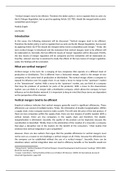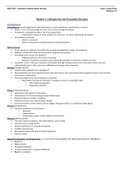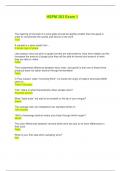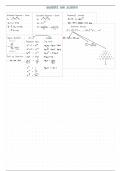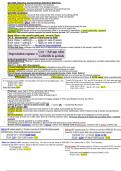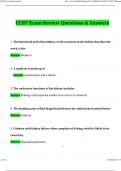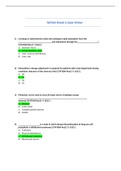“Vertical mergers tend to be efficient. Therefore the better policy is not to regulate them ex ante via
the EU Merger Regulation, but ex post by applying Article 102 TFEU should the merged entity restrict
competition post-merger.”
Mathijs Engels
U1274450
Introduction
In this essay, the following statement will be discussed: “Vertical mergers tend to be efficient.
Therefore the better policy is not to regulate them ex ante via the EU Merger Regulation, but ex post
by applying Article 102 TFEU should the merged entity restrict competition post-merger.” Firstly, the
term vertical merger is introduced and the statement that vertical mergers tend to be efficient will
be elaborated on. Secondly, the two different means of merger regulation will be discussed. Thirdly,
the two means of merger regulation will be compared and the similarities will be elaborated on.
Fourthly, relevant case law is examined to study the effects of the two means of merger regulation.
Lastly, the findings will be concluded.
What are vertical mergers?
Vertical merger is the term for a merging of two companies that operate at a different level of
production or distribution. This is different from a horizontal merger, which is the merger of two
companies in the same level of production or distribution. The vertical merger allows a company to
expand its influence over his supply chain. It can make a move to merge to the “upstream” market
or the “downstream” market. With a move to the “upstream” market, you can think of a company
that buys his producer of products (or parts of his products). With a move to the downstream
market, you can think of a merger with a distribution company, which allows the company to have
influence on his distribution network. It Is important to keep in mind that these terms are dependent
on the perspective of the observer.
Vertical mergers tend to be efficient
Empirical evidence indicates that vertical mergers generally result in significant efficiencies. These
efficiencies can consist of multiple factors. Firstly, the elimination of double-marginalisation. Within
a supply chain, every company wants to make a profit. This will raise the price of the end product. If
there are less companies within the supply-chain, there are less margins of profits needed. With a
vertical merger, there are less companies in the supply chain and therefore, the double-
marginalisation is eliminated. Secondly, the quality of the product can be improved, because the
coordination is intensified. Thirdly, there is the elimination of the creation of a maverick; a company
that plays a disruptive role in the market, for the benefit of the consumers. 1 Most studies find
evidence that vertical integration is pro-competitive 2.
However, there are also authors that argue that the possible efficiencies to vertical mergers must
not be seen as a reason to not challenge a vertical merger at all. Firstly, because the efficiencies for
the company can be established without the use of a vertical merger 3. Secondly, there can be
situations where vertical integration does not lead to efficiency benefits or the benefits would not
1
Wong-Ervin K, 'Antitrust Analysis Of Vertical Mergers: Recent Developments And Economic Teachings' [2018] SSRN
Electronic Journal, page 3
2
Cooper J and others, 'Vertical Antitrust Policy As A Problem Of Inference' (2005) 23 International Journal of
Industrial Organization, page 658
, outweigh the harm. Thirdly, some efficiencies are in practise harder to realise, because the acquiring
firm may lack expertise about the business of the acquired firm. Lastly, companies may sacrifice
potential efficiencies from eliminating double-marginalisation, in order to maintain the profits at the
same place.4
What we can conclude from this, is that vertical mergers are generally accompanied by efficiencies.
Some authors therefore plead for an ex post (after the merger) evaluation, but other authors
encourage a case-by-case ex ante (before the merger) evaluation to make sure that there are
efficiencies.
There are two possible ways to evaluate and regulate vertical mergers. The merger can be assessed
ex ante under article 2(3) of the EU Merger Regulation (EUMR) 5, or ex post under art. 102 of the
Treaty on the Functioning of the European Union (TFEU) 6 on grounds of abuse of dominance. Both
ways have their advantages and disadvantages. In the following section, I will elaborate on both of
them and discuss their advantages and disadvantages.
Ex ante regulation
Vertical mergers are evaluated and regulated through the EU Merger Regulation. Under this
regulation, the merger must fall within the scope of the regulation. The scope is stated in art. 1 of
the EUMR. If it falls within the scope, the European Commission must evaluate if the merger causes
a substantial impediment of effective competition 7. This evaluation is made ex ante. There are
advantages of ex ante regulation of vertical mergers compared to ex post regulating. Firstly, with ex
ante regulation, the European Commission is able to shape the market. By using structural and
behavioural measures, it has a big influence on the shape of the market. Secondly, it is economically
more logical to check beforehand if the merger can take place, regarding the costs a company must
make in case the merger is ruled unlawful. These costs will be larger if the evaluation of the merger
is ex post.
However, there are also some disadvantages to ex ante regulation. Firstly, the evaluation is based on
a hypothetical situation. This makes an ex ante regulatory decision questionable. Especially when
there is debate about what economic theories to follow in calculating this hypothetical situation.
Secondly, this practise makes the procedure inefficient. The procedure is costly and long, because
there are a lot of complicated calculations that need to be made. Thirdly, the decision can be very
radical. The stakes are always high, because there is a lot of money involved. Therefore, the
reasoning of the Commission must be elaborate. These problems have in common that the ex ante
procedure is based on theory. A major difficulty in relying on theory to regulate vertical mergers, is
that the conditions for vertical restraints to harm welfare are generally the same conditions under
which the practices increase consumer welfare. 8 Therefore, theory fails to provide a uniform test for
3
Jeffrey Church, Vertical Mergers, in 2 ABA SECTION OF ANTITRUST LAW, ISSUES IN COMPETITION LAW AND
POLICY 1455 (W. Dale Collins ed., 2008), 1495
4
Salop SD Culley, 'Vertical Merger Enforcement Actions: 1994-2015: Appendix To Revising The Vertical Merger
Guidelines: Policy Issues And An Interim Guide For Practitioners' [2015] SSRN Electronic Journal, page 12
5
Council Regulation (EC) 139/2004 on the control of concentrations between undertakings (EC Merger
Regulation) [2004] OJ L24/1, article 2(3)
6
Consolidated versions of the Treaty on European Union and the Treaty on the Functioning of the European Union,
[2007], OJ C326, article 102
7
Council Regulation (EC) 139/2004 on the control of concentrations between undertakings (EC Merger
Regulation) [2004] OJ L24/1, art. 2(3)
8
Cooper J and others, 'Vertical Antitrust Policy As A Problem Of Inference' (2005) 23 International Journal of
Industrial Organization, page 641
the EU Merger Regulation, but ex post by applying Article 102 TFEU should the merged entity restrict
competition post-merger.”
Mathijs Engels
U1274450
Introduction
In this essay, the following statement will be discussed: “Vertical mergers tend to be efficient.
Therefore the better policy is not to regulate them ex ante via the EU Merger Regulation, but ex post
by applying Article 102 TFEU should the merged entity restrict competition post-merger.” Firstly, the
term vertical merger is introduced and the statement that vertical mergers tend to be efficient will
be elaborated on. Secondly, the two different means of merger regulation will be discussed. Thirdly,
the two means of merger regulation will be compared and the similarities will be elaborated on.
Fourthly, relevant case law is examined to study the effects of the two means of merger regulation.
Lastly, the findings will be concluded.
What are vertical mergers?
Vertical merger is the term for a merging of two companies that operate at a different level of
production or distribution. This is different from a horizontal merger, which is the merger of two
companies in the same level of production or distribution. The vertical merger allows a company to
expand its influence over his supply chain. It can make a move to merge to the “upstream” market
or the “downstream” market. With a move to the “upstream” market, you can think of a company
that buys his producer of products (or parts of his products). With a move to the downstream
market, you can think of a merger with a distribution company, which allows the company to have
influence on his distribution network. It Is important to keep in mind that these terms are dependent
on the perspective of the observer.
Vertical mergers tend to be efficient
Empirical evidence indicates that vertical mergers generally result in significant efficiencies. These
efficiencies can consist of multiple factors. Firstly, the elimination of double-marginalisation. Within
a supply chain, every company wants to make a profit. This will raise the price of the end product. If
there are less companies within the supply-chain, there are less margins of profits needed. With a
vertical merger, there are less companies in the supply chain and therefore, the double-
marginalisation is eliminated. Secondly, the quality of the product can be improved, because the
coordination is intensified. Thirdly, there is the elimination of the creation of a maverick; a company
that plays a disruptive role in the market, for the benefit of the consumers. 1 Most studies find
evidence that vertical integration is pro-competitive 2.
However, there are also authors that argue that the possible efficiencies to vertical mergers must
not be seen as a reason to not challenge a vertical merger at all. Firstly, because the efficiencies for
the company can be established without the use of a vertical merger 3. Secondly, there can be
situations where vertical integration does not lead to efficiency benefits or the benefits would not
1
Wong-Ervin K, 'Antitrust Analysis Of Vertical Mergers: Recent Developments And Economic Teachings' [2018] SSRN
Electronic Journal, page 3
2
Cooper J and others, 'Vertical Antitrust Policy As A Problem Of Inference' (2005) 23 International Journal of
Industrial Organization, page 658
, outweigh the harm. Thirdly, some efficiencies are in practise harder to realise, because the acquiring
firm may lack expertise about the business of the acquired firm. Lastly, companies may sacrifice
potential efficiencies from eliminating double-marginalisation, in order to maintain the profits at the
same place.4
What we can conclude from this, is that vertical mergers are generally accompanied by efficiencies.
Some authors therefore plead for an ex post (after the merger) evaluation, but other authors
encourage a case-by-case ex ante (before the merger) evaluation to make sure that there are
efficiencies.
There are two possible ways to evaluate and regulate vertical mergers. The merger can be assessed
ex ante under article 2(3) of the EU Merger Regulation (EUMR) 5, or ex post under art. 102 of the
Treaty on the Functioning of the European Union (TFEU) 6 on grounds of abuse of dominance. Both
ways have their advantages and disadvantages. In the following section, I will elaborate on both of
them and discuss their advantages and disadvantages.
Ex ante regulation
Vertical mergers are evaluated and regulated through the EU Merger Regulation. Under this
regulation, the merger must fall within the scope of the regulation. The scope is stated in art. 1 of
the EUMR. If it falls within the scope, the European Commission must evaluate if the merger causes
a substantial impediment of effective competition 7. This evaluation is made ex ante. There are
advantages of ex ante regulation of vertical mergers compared to ex post regulating. Firstly, with ex
ante regulation, the European Commission is able to shape the market. By using structural and
behavioural measures, it has a big influence on the shape of the market. Secondly, it is economically
more logical to check beforehand if the merger can take place, regarding the costs a company must
make in case the merger is ruled unlawful. These costs will be larger if the evaluation of the merger
is ex post.
However, there are also some disadvantages to ex ante regulation. Firstly, the evaluation is based on
a hypothetical situation. This makes an ex ante regulatory decision questionable. Especially when
there is debate about what economic theories to follow in calculating this hypothetical situation.
Secondly, this practise makes the procedure inefficient. The procedure is costly and long, because
there are a lot of complicated calculations that need to be made. Thirdly, the decision can be very
radical. The stakes are always high, because there is a lot of money involved. Therefore, the
reasoning of the Commission must be elaborate. These problems have in common that the ex ante
procedure is based on theory. A major difficulty in relying on theory to regulate vertical mergers, is
that the conditions for vertical restraints to harm welfare are generally the same conditions under
which the practices increase consumer welfare. 8 Therefore, theory fails to provide a uniform test for
3
Jeffrey Church, Vertical Mergers, in 2 ABA SECTION OF ANTITRUST LAW, ISSUES IN COMPETITION LAW AND
POLICY 1455 (W. Dale Collins ed., 2008), 1495
4
Salop SD Culley, 'Vertical Merger Enforcement Actions: 1994-2015: Appendix To Revising The Vertical Merger
Guidelines: Policy Issues And An Interim Guide For Practitioners' [2015] SSRN Electronic Journal, page 12
5
Council Regulation (EC) 139/2004 on the control of concentrations between undertakings (EC Merger
Regulation) [2004] OJ L24/1, article 2(3)
6
Consolidated versions of the Treaty on European Union and the Treaty on the Functioning of the European Union,
[2007], OJ C326, article 102
7
Council Regulation (EC) 139/2004 on the control of concentrations between undertakings (EC Merger
Regulation) [2004] OJ L24/1, art. 2(3)
8
Cooper J and others, 'Vertical Antitrust Policy As A Problem Of Inference' (2005) 23 International Journal of
Industrial Organization, page 641

